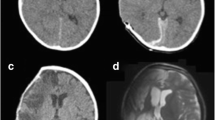Abstract
A 3-year-old boy was transferred to our hospital 2 weeks after sustaining severe burns to his head, face, and hands by a fire. Physical examination revealed a total burn surface area of approximately 15%, an exposed calvarium area of 26 cm × 22 cm, necrosis of the outer table calvarial bone, and granulation wounds (Fig. 40.1).
Access this chapter
Tax calculation will be finalised at checkout
Purchases are for personal use only
Similar content being viewed by others
References
Hierner R, van Loon J, Goffin J, van Calenbergh F. Free latissimus dorsi flap transfer for subtotal scalp and cranium defect reconstruction: report of 7 cases. Microsurgery. 2007;27:425–8.
Dupont C, Menard Y. Transposition of the greater omentum for reconstruction of the chest wall. Plast Reconstr Surg. 1972;49:263–7.
McLean DH, Buncke HJ Jr. Autotransplant of omentum to a large scalp defect, with microsurgical revascularization. Plast Reconstr Surg. 1972;49:268–74.
Irons GB, Witzke DJ, Arnold PG, Wood MB. Use of the omental free flap for soft-tissue reconstruction. Ann Plast Surg. 1983;11:501–7.
Shilov BL, Milanov NO. Free transfer of the greater omentum. Ann Plast Surg. 1993;31:546–9.
Weinzweig N, Yetman R. Transposition of the greater omentum for recalcitrant median sternotomy wound infections. Ann Plast Surg. 1995;34:471–7.
Arnold PG, Irons GB. The greater omentum: extensions in transposition and free transfer. Plast Reconstr Surg. 1981;67:169–76.
Ghazi BH, Carlson GW, Losken A. Use of the greater omentum for reconstruction of infected sternotomy wounds: a prognostic indicator. Ann Plast Surg. 2008;60:169–73.
O'Shaughnessy BA, Dumanian GA, Liu JC, Ganju A, Ondra SL. Pedicled omental flaps as an adjunct in the closure of complex spinal wounds. Spine. 2007;32:3074–80.
Harii K, Omori K, Omori S. Hair transplantation with free scalp flaps. Plast Reconstr Surg. 1974;53:410–3.
Lee B, Bickel K, Levin S. Microsurgical reconstruction of extensive scalp defects. J Reconstr Microsurg. 1999;15:255–62. discussion 63-4
Hultman CS, Carlson GW, Losken A, Jones G, Culbertson J, Mackay G, et al. Utility of the omentum in the reconstruction of complex extraperitoneal wounds and defects: donor-site complications in 135 patients from 1975 to 2000. Ann Surg. 2002;235:782–95.
Das SK. The size of the human omentum and methods of lengthening it for transplantation. Br J Plast Surg. 1976;29:170–44.
Gorgu M, Erdogan B, Akoz T, Aslan G, Ayhan M. Review of a classic method for repair of total scalp defects in childhood. Ann Plast Surg. 1998;40:105–6.
Gurtner GC, Evans GR. Advances in head and neck reconstruction. Plast Reconstr Surg. 2000;106:672–82.
Perlyn CA, Schmelzer R, Govier D, Marsh JL. Congenital scalp and calvarial deficiencies: principles for classification and surgical management. Plast Reconstr Surg. 2005;115:1129–41.
Wang HT, Erdmann D, Olbrich KC, Friedman AH, Levin LS, Zenn MR. Free flap reconstruction of the scalp and calvaria of major neurosurgical resections in cancer patients: lessons learned closing large, difficult wounds of the dura and skull. Plast Reconstr Surg. 2007;119:865–72.
McCombe D, Donato R, Hofer SO, Morrison W. Free flaps in the treatment of locally advanced malignancy of the scalp and forehead. Ann Plast Surg. 2002;48:600–6.
Sury F, Orry D, Parmentier J, Goga D, Laure B. Microdialysis monitoring of a free omentum flap. Rev Stomatol Chir Maxillofac. 2010;111:84–7.
Author information
Authors and Affiliations
Editor information
Editors and Affiliations
Rights and permissions
Copyright information
© 2021 The Author(s), under exclusive license to Springer Nature Singapore Pte Ltd.
About this chapter
Cite this chapter
Tang, J., Wu, P. (2021). Salvage of Large Scalp Defect with Exposed Skull Necrosis by a Free Vascularized Greater Omentum Graft in a 3-Year-Old Child: A Case Report and 10-Year Follow-Up. In: Hou, C., Chang, S., Tang, J., Cai, Z. (eds) Practical Microsurgery Cases. Springer, Singapore. https://doi.org/10.1007/978-981-15-9716-9_40
Download citation
DOI: https://doi.org/10.1007/978-981-15-9716-9_40
Published:
Publisher Name: Springer, Singapore
Print ISBN: 978-981-15-9715-2
Online ISBN: 978-981-15-9716-9
eBook Packages: MedicineMedicine (R0)




